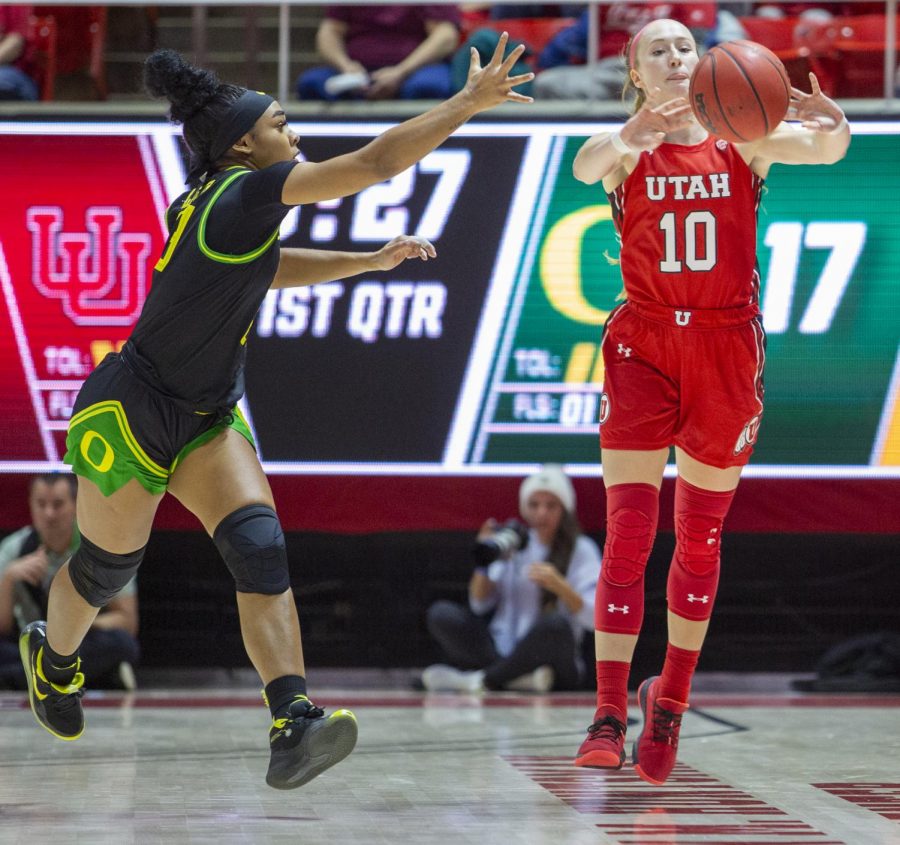Hold Women’s Sports at the Same Level You Do Men’s
University of Utah sophomore guard Dru Gylten (10) passes the ball during an NCAA Basketball game vs. the University of Oregon at the Jon M. Huntsman Center in Salt Lake City, Utah on Thursday, Jan. 30, 2020. (Photo by Jalen Pace | The Daily Utah Chronicle)
April 12, 2021
March Madness wrapped up a few days ago in the United State of America. The men’s basketball tournament produces $700 million per year. There is an issue though, and that issue was brought forth by Oregon’s Sedona Prince the first week of the women’s basketball tournament. The issue — the weight rooms and swag bags given to the women’s team were drastically different from the men’s.
The weight room for the women’s teams was just one weight rack, full of 10-30 pound dumbbells. In contrast, the men were given a weight room full of equipment, squat racks, bench presses, bands and even treadmills.
Such a disparity is disgusting, but it shouldn’t be surprising. Anyone who covers women’s sports knows these inequalities exist and those, honestly, start with coverage.
When was the last time you saw a women’s sporting event promoted on network television? When was the last time you read an ESPN article on the homepage about a WNBA game? Have you ever seen a major product advertise with a female athlete other than Serena Williams, Megan Rapinoe, or Naomi Osaka? The answer to all these questions is, “rarely,” or flat out “no.”
Coverage of women’s sports has grown over the past decades, but it still isn’t nearly enough. The Chronicle is fortunate to have a diversity of voices that help us have tremendous coverage of women’s athletics here at the University of Utah.
Outgoing sports editor Sammy Mora has done a tremendous job covering the U’s first-class gymnastics program. Brian Preece, Emily Dush and others have done a tremendous job covering the female-led teams here at the U. All that said, as the beat writer for the women’s basketball team, I can still safely say the sport is under-covered.
For a majority of the women’s games, I was the only print media member in the building this year. Granted, the team was down this year — but so was the men’s team. Yet we saw beat reporters from all over the state clamor to those games.
The fact the Salt Lake Tribune and Deseret News did little to no game coverage of the women’s games was shocking to me. Only tent pole games of the season got recaps, while game-to-game coverage fell solely on our paper.
An argument from an editor at one of those papers might be, “Well, people don’t track the women’s teams as closely as the men’s program.” But if they don’t, why do you think that is?
If you build it, they will come. If you provide coverage for women’s college athletics, people will read it. Fans are passionate about their schools — no matter what gender the athletes are.
You are also missing a huge swath of your audience if you aren’t covering women’s sports. It’s not just men that watch sports, and this should be an obvious statement in 2021. So why aren’t we covering women’s sports more thoroughly? Are you worried there will be some backlash from your readership if you start covering women’s games and putting that coverage up against the men’s?
Some people might be worried because sexism still exists in America. Women still make less than men, and the glass ceiling still exists. The only way to defeat that though is to provide coverage, and if that alienates a certain segment of your readership that believes you shouldn’t be doing that, then so be it. Those people are a dying breed.
Dinosaurs that believe women can’t do anything men can do still exist. Like the dinosaurs though, they will die off. As in life, the old, tired thinking eventually dies off with the people that hold those beliefs. We can’t do that though, we can’t wait for those dinosaurs to die off. We have to fight for female athletes now, and especially those at the college level.
At some level, we cover men’s college athletics because we want those covered to be recognized so they can be successful after college. The same is true of female athletes. Very few of the players on Utah’s women’s team will make the WNBA. Terrific athletes like Brynna Maxwell, Peyton McFarland and Andrea Torres still deserve to be covered. They deserve to have their stories told.
What are we showing the next generation of young girls in this country if they can’t find coverage of female athletes? You wonder why women aren’t as involved in sports? Maybe it’s because they can’t find coverage of their sport. You wonder why scouting reports of non-Utah teams are lacking? It’s because it is hard to find writing about women’s college basketball on the internet.
It is an under-covered sport, as are most women’s sports, and Sedona Prince shouldn’t have to go on TikTok to tell the world the NCAA is neglecting female athletes, journalists covering the sport should be doing that for her, but those people don’t exist and when they do they aren’t promoted in the same way men’s sports reporters are, they need to be they are the people that will help level the playing field.








